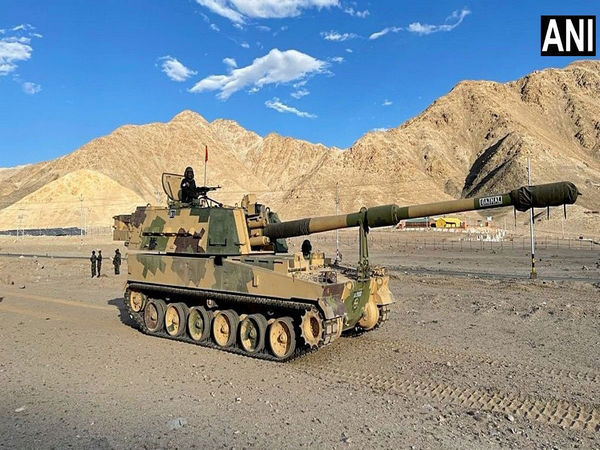
New Delhi: India’s defence exports have witnessed a more than 30-fold jump in the past 10 years, with global conflicts like the ongoing Russia-Ukraine war and the Israel-Hamas combat boosting the business further.
According to a latest media reports, India's growing defence industry now supplies to over 90 countries globally, with the government actively pushing easier licensing systems and approvals.
While the United States has emerged as the biggest defence export destination, the Indian government is also focusing on countries in Africa and elsewhere to supply defence equipment, with easier lines of credit and a diplomatic push, according to a report in ThePrint.
India's Ministry of Defence, in a media statement released earlier this year, said the country's defence exports had touched a record $ 2.63 billion in the Financial Year (FY) 2023-24, a growth of 32.5 percent over the last fiscal when the figure was $ 1.9 billion.
"The latest figures indicate that India's defence exports have grown by 31 times in the last 10 years as compared to FY 2013-14," as per the press release.
The defence Industry, including the private sector and Defence Public Sector Undertakings (DPSUs), have made enormous efforts in achieving the highest-ever defence exports.
The private sector and the DPSUs have contributed about 60 percent and 40 percent, respectively.
Additionally, there has been a rise in the number of export authorisations issued to the defence exporters during FY 2023-24.
From 1,414 export authorisations in FY 2022-23, the number jumped to 1,507 in FY 2023-24, according to data shared by the Indian government.
A comparative data of two decades — from 2004-05 to 2013-14 and from 2014-15 to 2023-24 — reveals that there has been a growth of 21 times in the defence exports.
"Total defence exports during 2004-05 to 2013-14 were approximately $ 510 million, which has gone up to $ 10.53 billion in the period from 2014-15 to 2023-24," as stated by the Government of India.
Government officials said this growth has been achieved due to the policy reforms and ‘Ease of Doing Business’ initiatives brought in by the Government of India, in addition to the end-to-end digital solution provided to the Indian industries for promoting defence exports.
"This growth is a reflection of global acceptability of Indian defence products and technologies," a senior official of the Union Ministry of Defence said.
Although the Indian government has not disclosed specific details about the types of exports or the countries involved, sources indicate that the country’s defence exports include a wide range of products.
These products range from ammunition, small arms like sniper rifles, and bulletproof jackets to more advanced items such as drones, light torpedoes, armoured vehicles, and fast attack ships, according to a report by News18.
While the United States is the largest importer, Myanmar has been a major buyer of Indian defence exports, particularly fuses and ammunition, reports News18, adding that Israel and Armenia have also emerged as important buyers of Made in India defence goods.
Notably, India has signed significant contracts, such as the BrahMos missile deal with the Philippines and deals for artillery and air defence systems with Armenia, while the United States accounts for nearly 50 percent of India’s total defence exports, making it the biggest buyer, as per reports.
The transformation in India’s defence exports can be attributed to three significant changes implemented 10 years ago — strategy, policy, and diplomacy.
According to a report by India Today, for the first time, the Indian government introduced a defence export strategy in September 2014, bringing together top bureaucrats to push for arms sales.
Later in 2020, the Narendra Modi government in the Centre had set an ambitious export target of $5 billion in aerospace and defence goods and services for the next five years, which was a part of the government’s plan to achieve a turnover of $25 billion in defence manufacturing by 2025.
This strategy was supported by policy changes aimed at building up India’s domestic defence manufacturing, reports India Today.
The Atma Nirbhar Bharat (Self Reliant India) initiative emphasised the importance of self-reliance, leading to the introduction of the Defence Acquisition Procedure in 2020, which prioritised Indian-made products for the armed forces, as reported by India Today.
Highlighting this strategic shift, Lt Gen H S Panag (Retd), a former Northern Army commander, told The Economic Times: "By 2013-14, our exports were a meagre $110 million (at then prevailing exchange rates)."
"A defence export strategy did not exist until August 2014. Exports were carried out under the Foreign Trade Policy after obtaining a no-objection certificate (NOC) from the Ministry of Defence [MoD]," Panag added.
"In September 2014, the Modi government formulated and promulgated a Strategy for Defence Exports. It focused on export promotion/facilitation, and regulation," the ex-Army commander was quoted as saying by The Economic Times.
Meanwhile, the Government of India also issued indigenisation lists, which banned the import of thousands of defence items, compelling home-grown firms to produce them domestically.
India Today reported, citing Delhi-based independent global think tank Observer Research Foundation, that this policy has been successful, with 62.5 percent of the items on the list already indigenised.
The country also made it easier for defence companies to meet compliance requirements and obtain export licences, reports India Today, adding that diplomatic efforts also played a crucial role in expanding India’s defence exports.
The Indian Ministry of External Affairs posted defence attachés in various countries to scout for military contracts, and India extended lines of credit to nations, particularly in Africa, enabling them to purchase Indian defence equipment at favourable terms, while countries like Sri Lanka, Vietnam, Guyana, and Tanzania have all benefited from these credit lines, according to the India Today report.